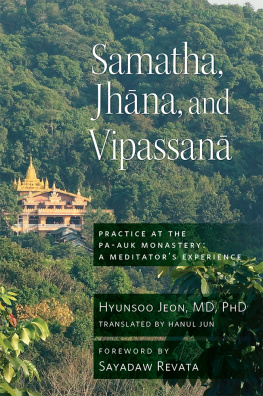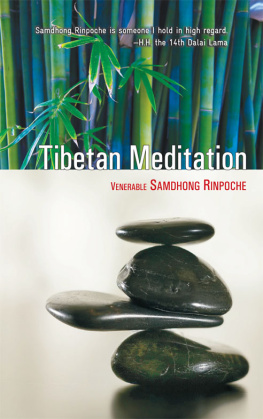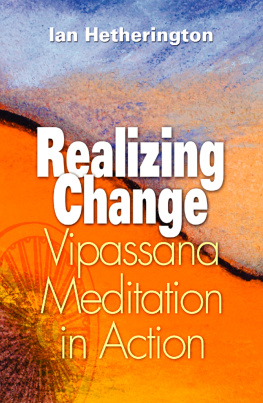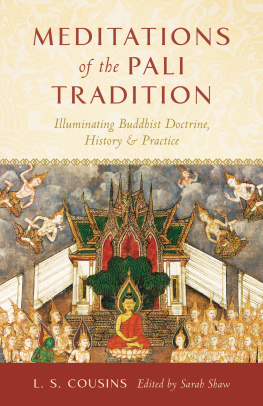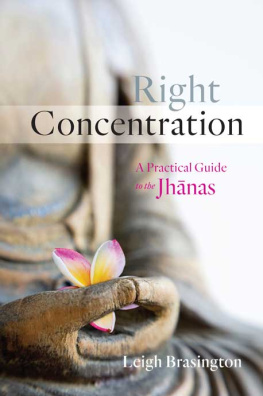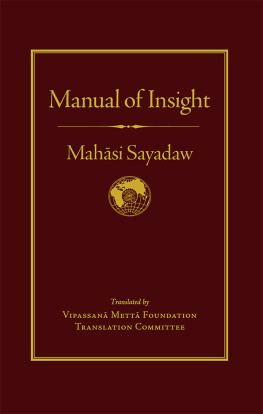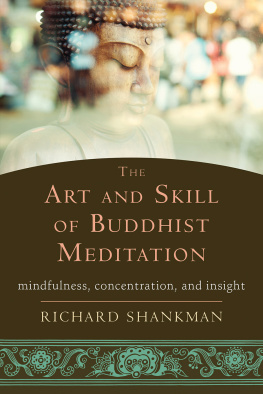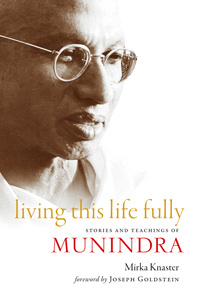This book is nothing short of extraordinary. With humility, clarity, and absolute fidelity to the original teachings, Dr. Jeon shares his direct experience of advanced states of absorption, along with technical details of practice, in a manner that makes the ancient texts come alive. This book will surely inspire meditators to practice more deeply and more sincerely for years to come.
Christopher Germer, Harvard Medical School, author of The Mindful Path to Self-Compassion
T HIS STEP-BY-STEP MEDITATORS GUIDE walks the reader through practices that hold the key to unlocking new levels of concentration and insight. A student of the famed Pa-Auk Monastery and a practicing psychiatrist, Hyunsoo Jeon, MD, PhD, uses these two paths to guide readers to a new understanding of themselves and the world around them.
Drawing both from Jeons own experience with Pa-Auk Sayadaw and from the words of the Buddha, this is an authentic and practical guide to samatha; meditation on materiality, mentality, and dependent origination; and vipassan.
HYUNSOO JEON is a psychiatrist and a psychotherapy specialist from Seoul, South Korea. He began using Buddhist wisdom to aid him in treating his patients and, after seeing how effective this could be, detailed his experiences in a range of books, including A Psychiatrists Wisdom from the Buddha: Stories of Healing the Mind, A Psychiatrists Guidebook for the Mind, and Dr. Hyunsoo Jeons Lectures on Buddhist Psychotherapy. He opened the Hyunsoo Jeon Psychiatric Clinic in 1990.
List of Tables
Foreword
The purpose of practicing meditation is to know and to see the truth. The Buddha said:
Bhikkhus, develop concentration. One who is concentrated knows and sees the four noble truths as they really are.
The Discourse on Concentration, SN 56.1
The author of this book has successfully developed concentration, and he shares his personal experience of samatha and vipassan practice through this book. With the help of the light of concentration, he was able to see what is beyond the naked eye.
The Buddha, through the omniscient knowledge he attained by means of concentration, was able to know the existence of beings living in other realms, such as the brahma, deva, ghost, and hell beings, as well as the corresponding causes of rebirth in these realms. As a perfectly self-enlightened one, he taught about these realms when he expounded the Dhamma.
The author of the present work practiced the Dhamma as it was taught by the Buddha, so that, with the help of the light of concentration, which can illumine one to see what is beyond the naked eye, the author himself was also able to see such beings. He was able to see tree gods, hungry ghosts, heavenly beings, and hell beings. He knew for himself that these beings exist. With the help of the light of concentration, he was also able to see his various internal organs such as the heart, the liver, the spleen, and the kidneys very clearly through the practice of meditation on the thirty-two constituent parts of the body. He could see the five aggregates of clinging in the form of ultimate materiality and mentality, which is the first noble truth. He was also able to see his past lives and future lives, and understand the causes and effects of these existences. This means he was able to see and understand the second noble truth, which is the truth of dependent origination.
The Bodhisatta gained supreme enlightenment under the bodhi tree because he had penetrated the first noble truth, the second noble truth, the third noble truth, and the fourth noble truth. Anyone who wants to gain enlightenment needs to see the four noble truths.
As one who got the opportunity to practice meditation according to the way taught by the omniscient Buddha, the author could practically experience and see the teachings for himself, according to his concentration and capability. He then describes them for aspiring practitioners who would also like to see for themselves such deep and profound reality, which is beyond the naked eye.
Anyone who wishes to see things directly, as they really are, needs to develop concentration. If you have developed concentration, you too, with the help of the light of concentration, or the light of wisdom, will know and see things you have never seen before in your life. Through seeing them, you will be enlightened.
This is a book that conveys a profound message to those who would like to know and see the truths as they really are. But this book cannot serve as a stand-alone manual. Whoever would like to practice needs to find a qualified teacher to practice systematically in more detail.
As the Buddha said:
This Dhamma that I have attained is profound, hard to see and hard to understandunattainable by mere reasoning, subtle, to be experienced by the wise. It is hard for this generation to see this truth, namely, specific conditionality, Dependent Origination.
The Discourse on the Noble Search, MN 26.19
When the author of the present book writes about causality and causal relationships about dependent origination his explanation will be difficult to understand just by reasoning. As the Buddha says in the above quote, seeing the truth of dependent origination is unattainable by such methods. One can realize this truth only through direct knowledge, which can be attained with the help of the light of concentration. So if the reader encounters difficulty in understanding these parts of the book, it is only to be expected.
Without concentration, the Dhamma is hard to see and hard to understand. Unless we understand it, however, our liberation is utterly impossible. As the Buddha said to nanda:
This dependent origination is deep and appears deep. It is because of not understanding and not penetrating this Dhamma, nanda, that this generation, which delights in sensuality like a knotted ball of thread does not pass beyond the plane of misery, the bad destinations, the nether world, sasra.
The Discourse on Causation, SN 12.60
Both you and I wander in sasra because we do not know dependent origination. It is deep and profound but it is possible for us to realize it. Those who would like to realize this truth need to see it directly. It is difficult to see, but as the Buddha said, one who is concentrated will know and will see the truths as they really are. So one who has developed concentration will know and see them, unlike one who just reads but has not developed concentration.
The Buddha does not urge anyone to come and believe but to come and see. In other words, the four noble truths are not articles of faith; they are not something we hear or read and then simply believe. They are to be known by the wise that is, the wise can know and see these truths for themselves. One who develops right concentration will know and see them with absolute certainty.
May this book be a motivation for those who would like to attain enlightenment.
May this book inspire those who would like to be free from all suffering.
Sdhu! Sdhu! Sdhu!
Much mett,
Bhikkhu Revata
Pa-Auk Meditation Centre, Singapore
A Few Words from the Translator
Any work of translation requires a delicate balance between adhering closely to the original language and making sure that the proper meanings are conveyed. This project has involved a series of exchanges between the author and translator to achieve this difficult goal.
As the translator, I would like to clarify a few decisions I have made during the process, all of which I have discussed with the author.
First, since this is a book on Buddhist meditation, many concepts have been expressed in Pli. We have provided working English definitions whenever it was deemed necessary and offered a comprehensive glossary to aid the reader.

